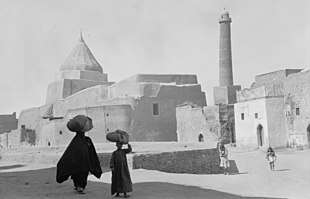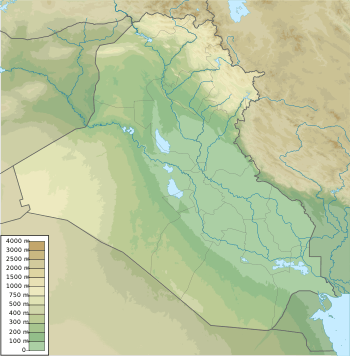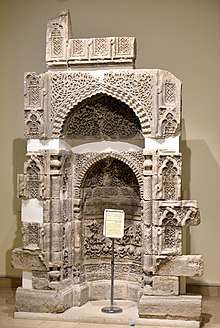Great Mosque of al-Nuri (Mosul)
The Great Mosque of al-Nuri (Arabic: جامع النوري, romanized: Jāmiʿ an-Nūrī) was a mosque in Mosul, Iraq. It was famous for its leaning minaret, which gave the city its nickname "the hunchback" (الحدباء al-Ḥadbāˈ). Tradition holds that the mosque was first built in the late 12th century, although it underwent many renovations over the years. The mosque withstood various hostile invading forces over its 850-year history until it was destroyed with its distinctive minaret in the Battle of Mosul in 2017.
| Great Mosque of al-Nuri Nouri Mosque | |
|---|---|
 Al Nouri mosque in 1932 | |
| Religion | |
| Affiliation | Islam |
| Ecclesiastical or organisational status | Mosque |
| Status | Destroyed |
| Location | |
| Location | Mosul, Nineveh Governorate, Iraq |
 Location in Iraq | |
| Geographic coordinates | 36°20′35″N 43°7′36″E |
| Architecture | |
| Style | Islamic architecture |
| Creator | Nur ad-Din Zangi |
| Completed | 1172–1173 AD |
| Destroyed | 21 June 2017 |
| Specifications | |
| Minaret(s) | 1 (since destroyed; now under reconstruction) |
| Minaret height | 45 metres (148 ft) |
| Materials | Brick, stone, hazarbaf |
Iraqi troops attributed the destruction of the Great Mosque to the Islamic State of Iraq and the Levant (ISIL)[1] in a vandalistic move to destroy it rather than let it go from their hold. The mosque had held a symbolic importance to ISIL and its leader, Abu Bakr al-Baghdadi, as it was used in 2014 by the militants to self-declare their "caliphate". ISIL's black flag had been flying on the 45-metre minaret after their militants surged across Iraq and Syria seizing territory, and they had promised to never let their flag be lowered from it. Contrary to official accounts and local eyewitnesses, ISIL alleged that U.S. forces destroyed it. ISIL's claim was not substantiated. The BBC reported that "IS accused the United States-led coalition aircraft of bombing the site, but experts said a video circulated online appeared to show charges inside the structures exploding."[2]
Iraqi Prime Minister Haider al-Abadi stated that the destruction of the mosque by ISIL was a "declaration of defeat",[3] and that "[b]lowing up the al-Hadba minaret and the al-Nuri mosque amounts to an official acknowledgment of defeat [by ISIS]."[4]
Construction

Tradition holds that Nur ad-Din Zangi, a Turkoman atabeg of the Great Seljuk Empire and sultan of its Syrian province, built the mosque in 1172–1173, shortly before his death.[5] According to the chronicle of Ibn al-Athir, after Nur ad-Din took control of Mosul he ordered his nephew Fakhr al-Din to build the mosque:
[Nur ad-Din] rode in person to its site and viewed it. He climbed the minaret of the mosque of Abu Hadir, looked down on the site of his mosque and ordered that the neighboring houses and shops should be added to the land that he viewed but that nothing should be taken without the willing agreement of the owners. He put the Sheikh Umar al-Malla in charge of the project, a pious and good man. The properties were purchased from their owners at most substantial prices and the construction began, on which large sums were expended. The building was completed in the year 568 [i.e. AD 1172-3].[6]
In 1511, the mosque was extensively renovated by the Safavid Empire.
Minaret


The mosque was well known for its leaning minaret, known as al-Hadba’ ("the hunchback"). Grattan Geary, a 19th-century traveler, described the minaret's appearance:
It is several feet out of the perpendicular, though it starts fair from the ground, and at the top, before putting on its gallery and dome, it regains an erect posture. Its attitude is that of a man bowing.[7]
When the cylindrical minaret was built it stood 45 metres (148 ft) high, with seven bands of decorative brickwork in complex geometric patterns ascending in levels towards the top. By the time the traveler Ibn Battuta visited in the 14th century it was already listing and had acquired its nickname.[8] The design of the minaret follows a form originally developed in neighboring Iran and Central Asia and shares similarities with other minarets in northern Iraq, such as those in Mardin, Sinjar and Arbil.[9]
According to local tradition (which resolutely ignores chronology), the minaret gained its tilt after the Prophet Muhammad passed overhead while ascending to heaven. The minaret bowed itself in reverence but could only regain its balance after its top joint had been kinked in the opposite direction.[10] According to local Christian tradition, however, the mosque's tilt was due to its bowing towards the tomb of the Virgin Mary, reputedly located near Arbil.[7] It is also nicknamed by some as Iraq's 'Tower of Pisa', as the mosque's signature tilt was compared to that of the Torre di Pisa in Italy.[11]
Modern history
Both the mosque and its madrasa were dismantled and reassembled in 1942 in a restoration programme undertaken by the Iraqi government.[8] The minaret remained unrestored, although attempts were made in 1981 by an Italian firm to stabilise it. The bombing of Mosul during the Iran–Iraq War in the 1980s broke underground pipes and caused leaks under the minaret that further undermined it. The lean later worsened by another 40 centimetres (16 in).[12]
The cause of the lean was disputed – some have blamed the prevailing wind – but local officials have attributed it to the effects of thermal expansion caused by the heat of the sun, causing bricks on the sun-facing side to expand and progressively tilt the minaret.[12] In recent years cracks proliferated along the base of the minaret, which leant nearly 3 metres (9.8 ft) off vertical. It was listed by the World Monuments Fund as a site of concern due to the ongoing risk of collapse.[8]
The structure was targeted by Islamic State of Iraq and the Levant militants who occupied Mosul on 10 June 2014, and previously destroyed the Tomb of Jonah. However, residents of Mosul, incensed with the destruction of their cultural sites, protected the mosque by forming a human chain and forming a resistance against ISIL.[13] Rather than destroying the site, Abu Bakr al-Baghdadi appeared during a Friday prayer in this mosque on 4 July 2014 to declare the formation of a new caliphate.[14]
Destruction

By June 2017, the Battle of Mosul had progressed to the stage that ISIL-controlled territory in Mosul was limited to the Old City area, which included the mosque. On 21 June 2017, Iraqi government forces reported that the mosque had been blown up by ISIL forces at 9:50 PM and that the blast was indicative of bombs being deliberately placed to bring it down.[15]
Amaq, an information wing of ISIL that often reports news favorable to the terrorist organization, claimed an airstrike by the United States was responsible for the destruction, but this claim was not substantiated by any evidence.[3][5][16]
Iraqi forces were within 50 metres (160 ft) of the mosque before the explosion,[5] and finally captured the site a week later on 29 June.[17][18] Aerial photographs and a video of the destruction were released by the Iraqi military a few hours after the explosion.[3] The video, particularly, clearly showed charges inside the structure exploding.[2]
Iraqi Prime Minister Haider al-Abadi stated that the destruction of the mosque was ISIL's "declaration of defeat".[15] BBC News journalist Paul Adams interpreted the mosque's destruction as ISIL's "final act of angry defiance before finally losing their grip on Mosul".[3]
Reconstruction
On April 23, 2018, United Arab Emirates (UAE) pledged to reconstruct the mosque.[19] The UAE will provide US$50.4 million to fund the reconstruction project with a joint collaboration between the UAE, UNESCO, Iraq's culture ministry, and the International Center for the Study of the Preservation and Restoration of Cultural Property (ICCROM).[20] During the announcement, the UAE minister of Culture and Knowledge Development Noura Al Kaabi spoke at the Chatham House in central London and stated that "This is an initiative that defeats extremism in all its facets" and "We don't want to allow the destruction of the past and the present".[21] The project basis is to preserve what's left of the leaning minaret and reconstruct it and make it retain its previous position in Mosul skyline while preserving the base of the minaret, as well as the square prism, as a memorial to the victims of ISIS.[21] The joint committee held its first meeting in September 2018 in the UAE hosted by the UAE Minister of Culture, Noura Al Kaabi. The expected completion date of the planned reconstruction is in 2023.[22] The reconstruction began on December 17, 2018.[23]
See also
References
- Hamdi Alkhshali, Barbara Starr and Phil Gast. "US, Iraq say ISIS blew up famous Mosul mosque". CNN. Retrieved 22 June 2017.
- "Battle for Mosul: Ruins of Great Mosque of al-Nuri retaken". BBC News. 29 June 2017. Retrieved 29 June 2017.
- "Battle for Mosul: Destruction of al-Nuri mosque 'shows IS defeated'". BBC. 22 June 2017. Retrieved 22 June 2017.
- "Anger after 800-year-old mosque is demolished by Islamic State". news.com.au. 23 June 2017. Retrieved 23 June 2017.
- "Iconic Grand al-Nuri mosque in Iraq's Mosul 'blown up'". Al Jazeera. 21 June 2017. Retrieved 21 June 2017.
- Richards, Donald Sidney (2008). The chronicle of Ibn al-Athı̄r for the crusading period from al-Kamil fi'l-Ta'rikh: The years 541-589/1146-1193, Volume 2. Aldershot, Hants: Ashgate Publishing, Ltd. p. 193.
- Geary, Grattan (1878). Through Asiatic Turkey: narrative of a journey from Bombay to the Bosphorus, Volume 2. London: Sampson Low, Marston, Searle & Rivington. p. 88.
- "Al-Hadba' Minaret". World Monuments Fund. Retrieved 27 June 2011.
- Petersen, Andrew (1996). Dictionary of Islamic Architecture (Pbk. 1999. ed.). London: Routledge. p. 189. ISBN 978-0-203-20387-3.
- Luke, H. C. (1925). Mosul and its minorities. London: Martin Hopkinson & Co. p. 19.
- "Heartbreak over ISIS destruction of Mosul mosque and iconic minaret, Iraq's 'Tower of Pisa'". Straits Times. Retrieved 22 June 2017.
- Sami, Mariam (3 October 1998). "Is tower bowing or tumbling?". The Associated Press.
- Kariml, Ammar; Mojon, Jean-Marc. 'In Mosul, resistance against ISIS rises from city’s rubble'. 31 July 2014. The Daily Star: Lebanon, retrieved 31 July 2014
- Strange, Hannah. 'Islamic State leader Abu Bakr al-Baghdadi addresses Muslims in Mosul'. 5 July 2014. The Daily Telegraph , retrieved 2 March 2017
- Chulov, Martin; Shaheen, Kareem (22 June 2017). "Destroying Great Mosque of al-Nuri 'is Isis declaring defeat'". The Guardian. Retrieved 22 June 2017.
- "Battle for Mosul: IS 'blows up' al-Nuri mosque". BBC. 21 June 2017. Retrieved 21 June 2017.
- "Iraqi forces take landmark Mosul mosque blown up by IS". Times of Malta. 29 June 2017. Retrieved 29 June 2017.
- "Iraq declares end of caliphate after capture of Mosul mosque". 29 June 2017 – via Reuters.
- Melissa Gronlund.'UAE funds rebuilding of Mosul’s Al Nuri Mosque and historic minaret'. 23 April 2018. The National , retrieved 23 April 2018
- "UAE to fund $50.4 million project to rebuild Mosul's Grand al-Nuri Mosque". Reuters. 23 April 2018.
- "UAE rebuilding of Mosul mosque 'defeats extremism'". The National. 9 July 2018.
- "Rebuilding Mosul: committee holds first UAE meeting for restoration of Al Nuri Mosque". The National. 14 September 2018.
- "Iraq begins rebuilding of Mosul landmark Great Mosque of al-Nuri". BBC. 17 December 2018.
External links
| Wikimedia Commons has media related to Nouri Mosque. |
- Fisk, Robert (29 June 2017). "The destruction of the al-Nuri mosque in Mosul is another example of the 'culturecide' we've become so used to". The Independent.

.jpg)